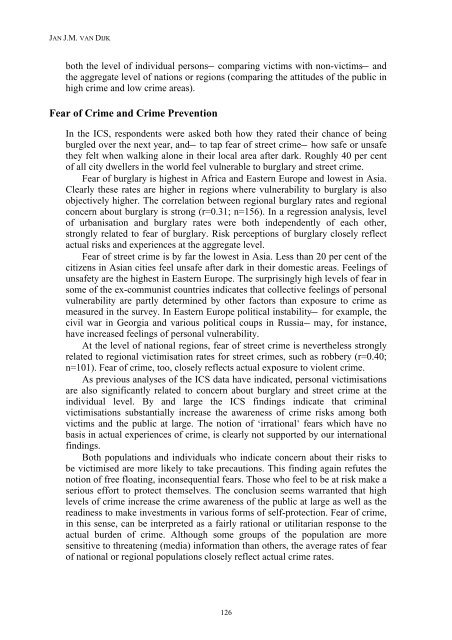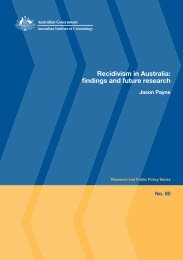Crime and victim surveys - Australian Institute of Criminology
Crime and victim surveys - Australian Institute of Criminology
Crime and victim surveys - Australian Institute of Criminology
Create successful ePaper yourself
Turn your PDF publications into a flip-book with our unique Google optimized e-Paper software.
JAN J.M. VAN DIJK<br />
both the level <strong>of</strong> individual persons⎯ comparing <strong>victim</strong>s with non-<strong>victim</strong>s⎯ <strong>and</strong><br />
the aggregate level <strong>of</strong> nations or regions (comparing the attitudes <strong>of</strong> the public in<br />
high crime <strong>and</strong> low crime areas).<br />
Fear <strong>of</strong> <strong>Crime</strong> <strong>and</strong> <strong>Crime</strong> Prevention<br />
In the ICS, respondents were asked both how they rated their chance <strong>of</strong> being<br />
burgled over the next year, <strong>and</strong>⎯ to tap fear <strong>of</strong> street crime⎯ how safe or unsafe<br />
they felt when walking alone in their local area after dark. Roughly 40 per cent<br />
<strong>of</strong> all city dwellers in the world feel vulnerable to burglary <strong>and</strong> street crime.<br />
Fear <strong>of</strong> burglary is highest in Africa <strong>and</strong> Eastern Europe <strong>and</strong> lowest in Asia.<br />
Clearly these rates are higher in regions where vulnerability to burglary is also<br />
objectively higher. The correlation between regional burglary rates <strong>and</strong> regional<br />
concern about burglary is strong (r=0.31; n=156). In a regression analysis, level<br />
<strong>of</strong> urbanisation <strong>and</strong> burglary rates were both independently <strong>of</strong> each other,<br />
strongly related to fear <strong>of</strong> burglary. Risk perceptions <strong>of</strong> burglary closely reflect<br />
actual risks <strong>and</strong> experiences at the aggregate level.<br />
Fear <strong>of</strong> street crime is by far the lowest in Asia. Less than 20 per cent <strong>of</strong> the<br />
citizens in Asian cities feel unsafe after dark in their domestic areas. Feelings <strong>of</strong><br />
unsafety are the highest in Eastern Europe. The surprisingly high levels <strong>of</strong> fear in<br />
some <strong>of</strong> the ex-communist countries indicates that collective feelings <strong>of</strong> personal<br />
vulnerability are partly determined by other factors than exposure to crime as<br />
measured in the survey. In Eastern Europe political instability⎯ for example, the<br />
civil war in Georgia <strong>and</strong> various political coups in Russia⎯ may, for instance,<br />
have increased feelings <strong>of</strong> personal vulnerability.<br />
At the level <strong>of</strong> national regions, fear <strong>of</strong> street crime is nevertheless strongly<br />
related to regional <strong>victim</strong>isation rates for street crimes, such as robbery (r=0.40;<br />
n=101). Fear <strong>of</strong> crime, too, closely reflects actual exposure to violent crime.<br />
As previous analyses <strong>of</strong> the ICS data have indicated, personal <strong>victim</strong>isations<br />
are also significantly related to concern about burglary <strong>and</strong> street crime at the<br />
individual level. By <strong>and</strong> large the ICS findings indicate that criminal<br />
<strong>victim</strong>isations substantially increase the awareness <strong>of</strong> crime risks among both<br />
<strong>victim</strong>s <strong>and</strong> the public at large. The notion <strong>of</strong> ‘irrational’ fears which have no<br />
basis in actual experiences <strong>of</strong> crime, is clearly not supported by our international<br />
findings.<br />
Both populations <strong>and</strong> individuals who indicate concern about their risks to<br />
be <strong>victim</strong>ised are more likely to take precautions. This finding again refutes the<br />
notion <strong>of</strong> free floating, inconsequential fears. Those who feel to be at risk make a<br />
serious effort to protect themselves. The conclusion seems warranted that high<br />
levels <strong>of</strong> crime increase the crime awareness <strong>of</strong> the public at large as well as the<br />
readiness to make investments in various forms <strong>of</strong> self-protection. Fear <strong>of</strong> crime,<br />
in this sense, can be interpreted as a fairly rational or utilitarian response to the<br />
actual burden <strong>of</strong> crime. Although some groups <strong>of</strong> the population are more<br />
sensitive to threatening (media) information than others, the average rates <strong>of</strong> fear<br />
<strong>of</strong> national or regional populations closely reflect actual crime rates.<br />
126















